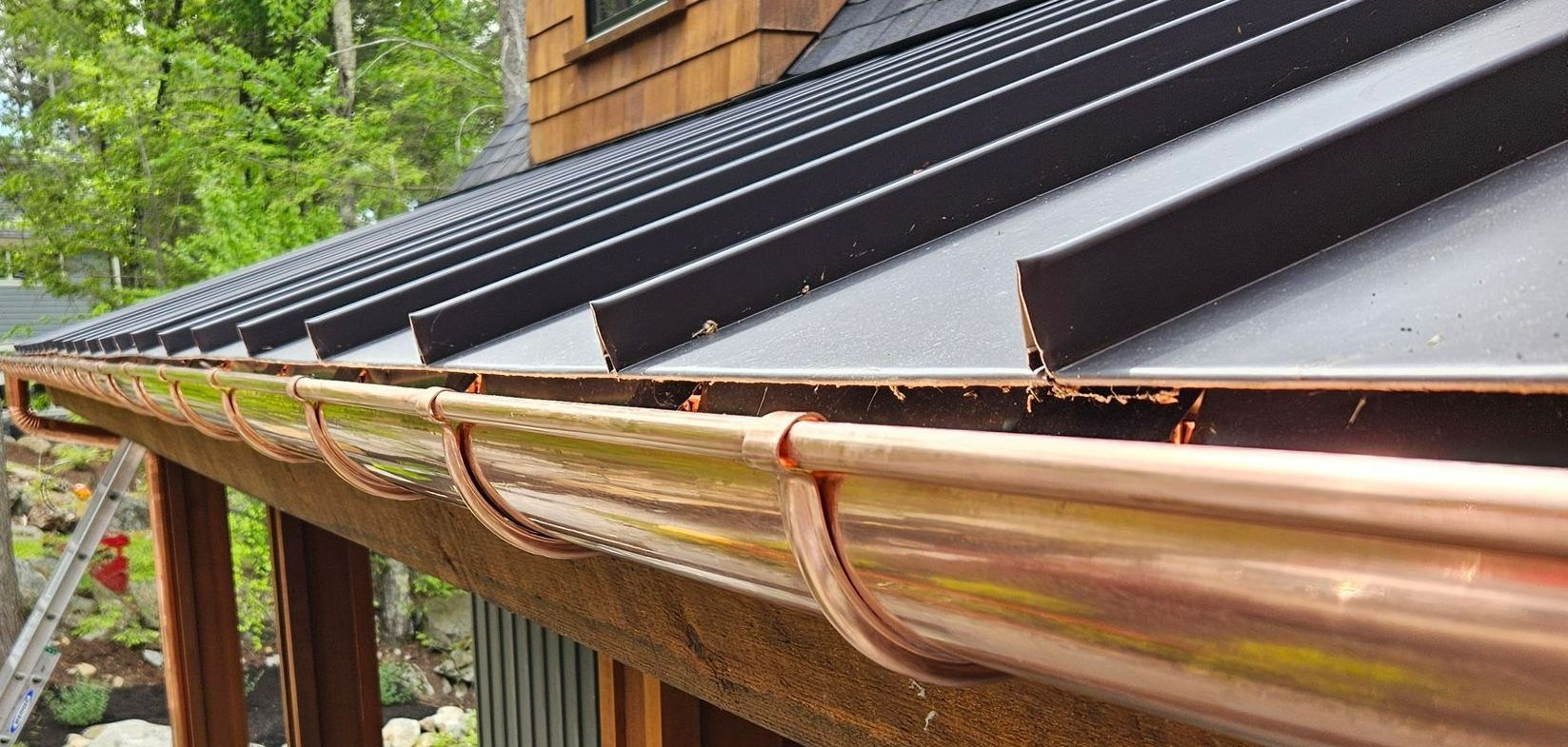What Size Gutters Do You Need? How To Calculate Roof Pitch and Size
How to Calculate Roof Pitch and Choose the Right Gutter Size for Your New Hampshire, Maine, or Massachusetts Home

What size gutters do you need? In order to find the right gutter size for your home or business first we need to do is calculate the roof pitch and size.
Here is a step-by-step guide on how to pick the right gutter size.
At New England Gutter Systems, we understand that choosing the right gutters for your home or business is essential to protecting your property from water damage. Whether you're located in the lush landscapes of New Hampshire, along the rugged coasts of Maine, or the historic homes of Massachusetts, ensuring proper water drainage is critical to maintaining the longevity of your roof and foundation.
One of the key factors in determining the best gutter system is understanding your roof pitch—the steepness or slope of your roof. This simple yet crucial calculation will help you select the appropriate gutter size to manage water runoff, especially in areas that experience heavy rainfall or snowfall. Not sure what gutter size you need? Don’t worry, we’ve got you covered.
Step-by-Step Guide: How to Calculate Your Roof Pitch
Calculating your roof pitch is important when planning for gutter installation or upgrades. The roof pitch influences the design, water drainage, and the types of materials best suited for your roof.
Here's how you can calculate it easily at home:
Tools You'll Need:
- A tape measure or ruler
- A level (at least 2 feet long)
- A ladder (if measuring on the roof)
- A pencil and paper for noting measurements
Steps to Calculate Your Roof Pitch:
1. Find a Safe Spot to Measure:
You can either measure from the roof or from inside your attic along a rafter. Ensure you're in a safe location, especially if you're using a ladder.
2. Measure the Run (Horizontal Distance):
Place your level horizontally on the roof or rafter. The bubble inside the level should be centered for accuracy. Measure 12 inches along the level from where it touches the roof or rafter—this is the "run."
3. Measure the Rise (Vertical Distance):
At the 12-inch mark along your level, measure vertically from the bottom edge of the level down to the roof surface. This vertical distance is the "rise."
4. Calculate the Roof Pitch:
The pitch is expressed as a ratio of the rise to the run. Since you measured the rise over a 12-inch run, the pitch is the rise number you measured. For example, if your roof rises 6 inches over 12 inches of run, your roof pitch is 6/12.
Why Roof Pitch Matters When Choosing Gutters
Your roof pitch determines how quickly water will flow into your gutters. Steeper roofs, like those with a **9/12 or 12/12 pitch**, channel water faster, meaning you’ll need larger gutters to manage the increased runoff. Conversely, lower-pitch roofs, such as **4/12 or 5/12, may not require oversized gutters but still need to efficiently direct water away from the foundation.
Now that you know your roof pitch, let’s discuss how this impacts your gutter size selection.
Step-by-Step Guide to Choosing the Right Gutter Size
1. Calculate the Roof Drainage Area
To choose the correct gutter size, you need to calculate how much water your roof will channel into the gutters. This involves determining the total roof area and adjusting it for your roof pitch.
-Measure Roof Area:Multiply the length and width of each section of your roof to calculate the total roof area.
- Adjust for Roof Pitch: Roofs with steeper pitches collect more water. Use these adjustment factors based on your pitch:
- 1/12 to 3/12 pitch: Multiply roof area by 1.1
- 4/12 to 5/12 pitch: Multiply by 1.2
- 6/12 to 8/12 pitch: Multiply by 1.3
- 9/12 to 11/12 pitch: Multiply by 1.4
- 12/12 pitch or higher Multiply by 1.5
Example: If you have a 2,000 sq. ft. roof with a 6/12 pitch, multiply by 1.3, giving you an adjusted area of 2,600 sq. ft.
2. Determine Maximum Rainfall Intensity
Check local weather data to find out the maximum rainfall intensity for your area, typically measured in inches per hour. Homes in New Hampshire, Maine, and Massachusetts may experience varying levels of rainfall. The more rainfall you get, the larger your gutters need to be.
3. Match Gutter Size to Roof Area and Rainfall
Most residential gutters come in 5-inch or 6-inch sizes, but oversized options, like 7-inch gutters, may be necessary for larger roofs or high-rainfall regions. The most common styles are K-style gutters, which hold more water than half-round designs.
- 5-inch K-style gutters handle around 5,520 sq. ft. of roof area under moderate rainfall.
- 6-inch K-style gutters manage about 7,960 sq. ft., making them ideal for larger or steeper roofs.
- European Half-Round gutters, while more elegant, typically hold less water and may require upsizing in areas with high rainfall.
4. Optimize Downspout Placement
The number of downspouts and their placement is equally important for efficient water management. Ideally, plan for one downspout for every 600-800 sq. ft. of roof area. Larger gutter systems allow you to reduce the number of downspouts, but their size (commonly **2x3 inches** or **3x4 inches**) should match your gutter’s capacity. At New England Gutter Systems we use 3x4 downspouts asa standard. Years of experience has proven to us the larger downspouts the best choice for our New England climate and conditions.
-
5. Check Local Building Codes
Ensure that your gutter system complies with local building codes in New Hampshire, Maine, or Massachusetts. This may include specific requirements for gutter size, materials, and installation methods. Normally there is no permit requirement. However, if you live in a historical district you should check with the local historical association for guidance.
6. Consult a Professional
If you’re unsure about your measurements or the right gutter system for your roof’s needs ,contact New England Gutter Systems Our team of experts can calculate your roof pitch, assess your drainage needs, and recommend the best gutter size for your home or business.
Example Calculation for Gutter Size:
Let’s say you have a 2,000 sq. ft. roof with a **6/12 pitch**. After adjusting for pitch, your roof area is 2,600 sq. ft.
If your area’s maximum rainfall is 2 inches per hour, a **5-inch K-style gutter** may suffice. However, upgrading to a **6-inch gutter** would offer extra capacity and peace of mind, particularly if your roof has multiple slopes or you experience frequent heavy rains.
Why the Right Gutter Size Matters
Selecting the correct gutter size ensures that your home or business is protected from water damage, foundation issues, and landscaping erosion. Large roofs or steep pitches require gutters that can handle increased water flow, while smaller or flatter roofs can manage with standard sizes.
When you choose New England Gutter Systems, you get more than just a gutter installation—you get a customized solution tailored to your home’s unique needs. From European Half-Round Gutters Box Gutters Copper Gutters or K-style systems, and Gutter Guards we provide expert advice, installation, and ongoing support.
Ready for Gutter Installation?
Whether you’re still unsure about your roof pitch or know exactly what size gutters you need, New England Gutter Systems is here to help. We’ll guide you through every step, from calculating your roof’s water drainage needs to installing a system that looks great and works perfectly. Protect your home from the elements with a gutter system designed to last.
Contact us today for a consultation and take the first step in safeguarding your home or business.
Explore Our Work in New Hampshire, Maine, and Massachusetts
Browse our gallery to see how we’ve helped homes and businesses across the region with custom gutter solutions tailored for New England’s unique climate.















